Happy 50th birthday. Fiat barbie.
Barbie turned 50 on 9 March. Her birthday present? A Fiat Barbie. So Fiat. So Milano. via designophy [PR]
Barbie turned 50 on 9 March. Her birthday present? A Fiat Barbie. So Fiat. So Milano. via designophy [PR]
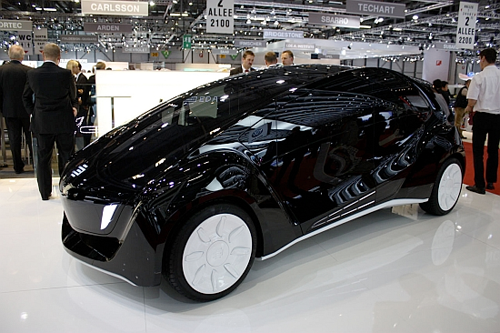
Automobile developer of low-volume concepts, EDAG hasn’t left any stone unturned with their newest concept the “Light Car – Open Source.”
Made from 100% recyclable basalt fiber chassis, the electric car can drive close to 100 miles on a full recharge.
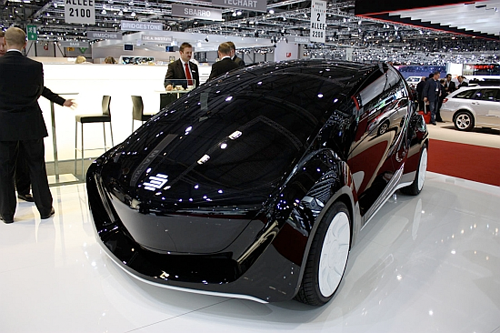
A feature that makes the car stand out is the use of high-end OLED technology all through the design. The rear of the car uses OLEDs to show trailing vehicles the amount of braking force needed to prevent a bang. The headlights and turn signals are all OLED panels that are invisible when off. The entire “glass cockpit” display system not only makes your ride technically advanced, but also allows the driver to position the speedometer anywhere he or she likes.
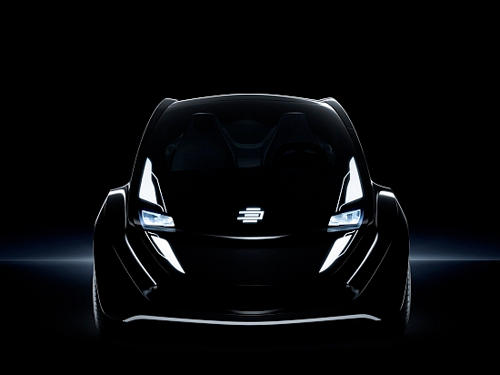
When will we see this car? Not for another decade as we wait for technology to catch up. Moreover, a range of 100 miles and a low top speed are also a few drawbacks that EDAG needs to look after.
What are OLEDs?
Producer: EDAG
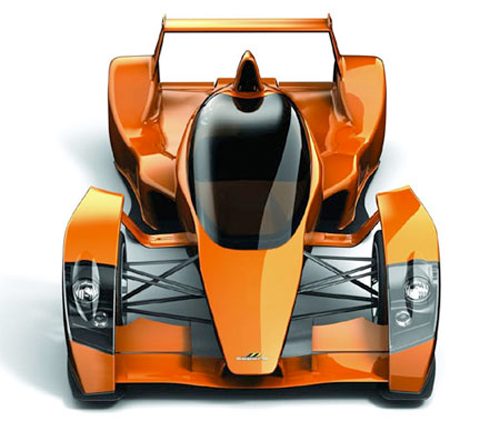
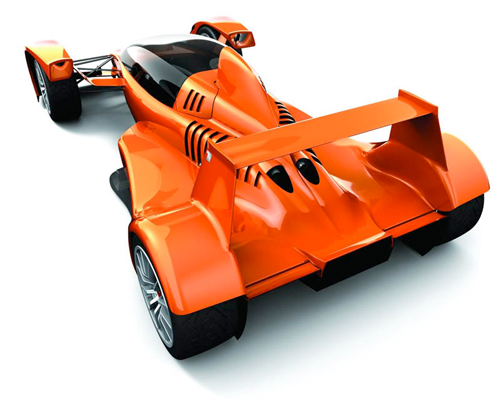
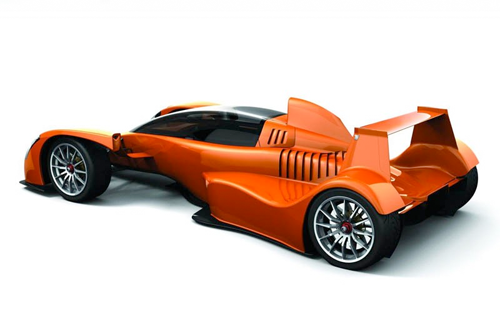
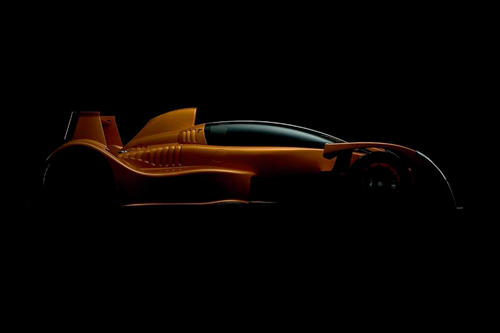
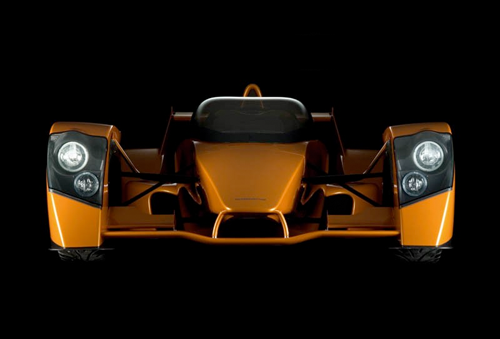
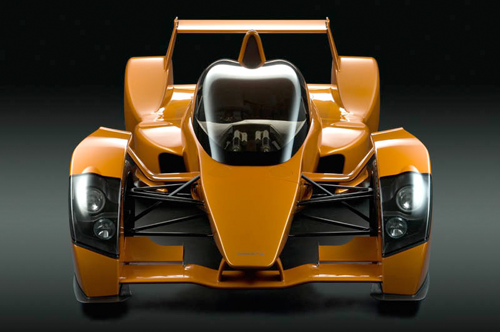
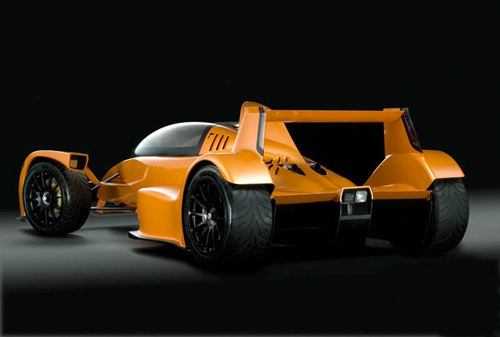

The Caparo T1 was in the press back in 2006. But now it is now production ready.
It’s as close as you’ll ever get to a genuine race car for the road. It’s been designed by a bunch of former McLaren Formula One engineers, and concedes only as much to practicality as is strictly necessary to make it street legal…maybe. Unveiled at the London Salon Privé at the prestigious Hurlingham Club, where final details on pricing, availability and a new sales and service network are expected to be announced shortly. Or go directly to the Caparo website.
Producer: Caparo
Jon Stewart: “Corn Ethanol F*#k That” – 2 Billion Cars Author Daniel Sperling via ecowonk [PR]
Chris bangle, BMW design chief, resigns. via businessweek [PR]

French firm MDI used the Geneva Motor Show to display a bubble-shaped three-wheeler that runs on air that it plans to roll out in 2009.
Drivers can recharge the air supply in eight hours by plugging the car into an electrical outlet or by going to an “air station” a process that takes two minutes. Priced at $7,500 USD.
Range: up to 137 miles
Speed: 40 miles per hour
Producer: MDI
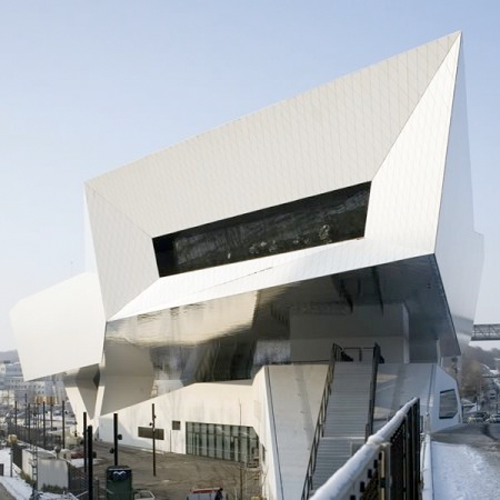
Vienna architects Delugan Meissl have completed work on the new Porsche Museum in Stuttgart-Zuffenhausen, Germany. The museum opens January 31, 2009.
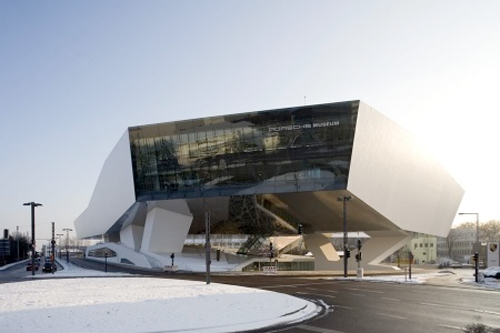
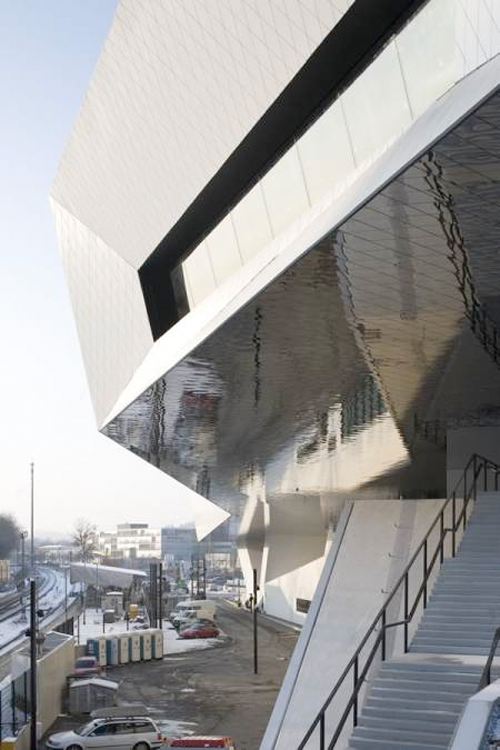

The museum will house around 80 chronologically-arranged vehicle exhibits and will be routinely replaced by other historical Porsches, as the majority of the exhibits can be driven on the road.
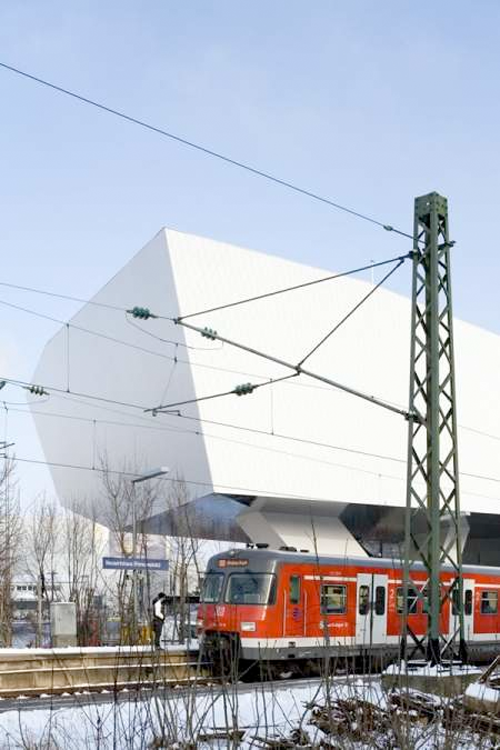
The company’s production and media archives will also be housed on-site, alongside a 3000-book library, shop, restaurant and conference facilities.

Photos are courtesy of Nathan Willock.
The following is from Porsche…
The Idea
The successful record of Stuttgart’s sports-car manufacturer – Porsche is both the smallest independent German automaker and the world’s most profitable automaker – is based on decades of experience in automotive manufacturing and in motorsports. The history of Porsche sports cars begins in 1948 with the legendary Type 356 “No. 1,” but the conceptual basis of the brand is the result of the lifelong work of Professor Ferdinand Porsche (1875–1951), which was continued by his son Ferry (1909–1998).
By establishing an independent engineering office in Stuttgart in 1931, Ferdinand Porsche laid the foundations for the House of Porsche, and he made automotive history by pioneering developments for his client companies. During the past six decades, Porsche has experienced many high points as well as low ones. But thanks to efficient production methods, distinctive positioning of its brand, and innovative models such as the 356, 911, 914, 924, 944, 928, and the Boxster and the Cayenne, the former sports-car specialist has developed into one of the world’s most successful automobile manufacturers.
This unique history is both an honor and an obligation. Porsche customers, shareholders, and Porsche fans had often expressed their wish for an inspiring place in which to display the corporate history, and in July 2004 Porsche’s Management Board responded by approving the construction of a new museum at Zuffenhausen’s Porscheplatz. Since October 2005, construction has been underway on a museum that will be an architectural emblem of the Porsche brand and make history as the most spectacular building project ever undertaken by the company. The elaborate new museum will be completed near the end of 2008 and will become the central repository where the Porsche tradition will be preserved and displayed.
The Location
Auto fans around the world know that the traditional site of Porsche AG is in Stuttgart-Zuffenhausen. Seventy years ago the erstwhile Porsche engineering office relocated from downtown Stuttgart to the first, newly built Porsche plant in Zuffenhausen. This is where the trial series of what became the “VW Beetle” was built in 1938, as was the forefather of all Porsche sports cars, the Type 64 “Berlin–Rome Car,” in 1939.
In 1950 this Stuttgart suburb became the birthplace of the sports cars bearing the Porsche logo. Today, the 911 model series and all Porsche engines are produced in Zuffenhausen. And Porsche’s new museum will be located here, on Porscheplatz. At this historic location, it will join the Porsche plant and the Porsche Center as the new emblem of the company.
The Architecture
There’s no doubt about it, even now: the new edifice by Vienna’s Delugan Meissl is an eye-catcher. Although the building isn’t quite finished yet, the fascinating impact of the monolithic, virtually floating exhibition hall can already be felt. This bold and dynamic architecture reflects the company’s philosophy and provides a foretaste of the experience that awaits visitors to the future museum. It is designed to convey a sense of arrival and approachability, and to guide the visitors smoothly from the basement level into the superstructure.
In their design, the architects at Delugan Meissl set out to create a place of sensuous experience that reflects the authenticity of Porsche products and services as well as the company’s character, while also reshaping Porscheplatz with an unmistakable appearance.
The Exhibits
About 80 vehicles and many small exhibits will be on display at the new Porsche Museum in a unique ambience. In addition to world-famous, iconic vehicles such as the 356, 550, 911, and 917, the exhibits include some of the outstanding technical achievements of Professor Ferdinand Porsche from the early 20th century. Even then, the name of Porsche stood for the commitment never to be satisfied with a technical solution that fails to fully meet or exceed all of its requirements, including opportunities for further improvement.
From the lobby, visitors ascend a spectacular ramp to the entrance of the spacious exhibition area, where they can gain an initial overview of the impressive collection.
Here the visitor is free to choose whether to start chronologically with the company history before 1948, or to head directly into the main area of the exhibition, which contains a chronological history of Porsche products and thematic islands. Both areas are interlinked by the “Porsche Idea” section, which forms the backbone of the exhibition.
The Idea section explains what makes the various themes and exhibits so unique. It tells of the spirit and the passion that motivate the work at Porsche, and pays tribute to the company as well as the people behind the product.
Concept
The new museum enlightens the visitor in an impressive, clear, and interesting manner about the entire history of what is now Dr. Ing. h.c. F. Porsche AG. Production cars have been just as important to the name recognition of the Porsche brand as many vehicles designed specifically for racing. Porsche designs have had an impact on individual mobility even in the early years of motorization.
The exhibition layout provides separate exhibit areas for the two periods before and after 1948. “Porsche Idea,” “Product History,” and “Thematic Islands” are the three core elements of the museum concept. Visitors making their way through the exhibition will often find these three main elements thematically interlinked.
The “Porsche Idea“ section focuses on specific, trailblazing technical solutions for interesting challenges from nearly all areas of mobility. Visitors can learn about the values, motivation, and philosophy driving the company throughout its history and to its ultimate success.
The “Product History” section is a chronologically arranged presentation of the history of Porsche sports cars from its beginnings in 1948 to the latest models with all their technological diversity and stylistic individuality.
“Thematic Islands” focus on particular, especially important aspects of Porsche history. Some of them, like “Evolution 911,” are dedicated to specific model series. Others bring together vehicles from different eras, for example in the splendid motorsport history of “Le Mans.”
The Racing Cars
Unlike many other museums, the new Porsche Museum stands for joie de vivre and variety. It will continue to remain committed to the long-established philosophy of the “Museum on Wheels” and will utilize, enhance, and expand the newly assembled collection in Zuffenhausen.
Next year, for instance, the 550 A Spyder will participate in the Mille Miglia, and the 356 Carrera Abarth GT will travel all the way to Australia for the Classic Adelaide.
Instead of a conventional, static exhibition, newly arranged object combinations will create an ever-changing display that reflects the self-image of a company that incorporates both a great tradition and great innovations.
With the “Museum on Wheels” Porsche is taking a route no one else has traveled. Even the classic vehicles in the museum’s collection are serving the purpose for which they were built in the first place: driving!
The Porsche Archive
A central repository is being created in the new museum where all of the historical and contemporary knowledge about the subject “Porsche” is being consolidated. The historical archive of Porsche AG is also moving into the new edifice, where portions of it are visible through glass walls from the lobby.
As the company’s “memory,” the Porsche Archive collects all important information concerning business, technical, social, or cultural matters relating to Porsche AG and its subsidiary companies. The archived items include anything worth saving about the unparalleled Porsche success story, from the beginnings of Ferdinand Porsche as an automobile designer to the engineering office established in 1931 all the way to today’s Porsche AG. The present files of the Porsche Archive cover 2,000 meters of shelf space, including bookshelves, display cases, steel cabinets, and safes.
The Historical Archive with its accumulated knowledge is available not only to internal departments but also to external users, such as journalists and scientists. Many thousands of inquiries annually are handled here in a professional manner by the Porsche archivists.
Designer: Delugan Meissl
Producer: Porsche
via dezeen
Description:
A comfortable pedal powered bicycle with weather protection.
Emphasis is made on automotive qualities in the design, to attract non-previous cyclists used to cars and motorcycles.
Another selling point to attract more people riding a bike (particularly here in Europe) is weather protection – ThisWay has a roof.
Built in composite materials (carbon or flax fiber) and some hydro-formed aluminum, this vehicle is very lightweight (approximately 11-12kg). It has built-in LED lights front and rear, powered by a rechargeable battery obtaining its power from roof mounted solar cells. For minimum maintenance ThisWay’s built-in belt drive is well protected and all cables are hidden within the frame.
The car-like ergonomics offers a riding position lower than a traditional bike to keep a low center of gravity and optimal aerodynamics.
The design has simple controls for ease of use; single hand brake lever and hub gears type Torpedo Duomatic providing Low and Hi gear.
The rear of the frame has a “luggage connector”, where the user plugs-in his/her luggage (e g briefcase, helmet box or rack for shopping bags). The design also benefits from flexibility and comfort for riders of different sizes, as the crankset and seat is adjustable in length/height.
A “hybrid” version (pedal power/electric motor) is possible and additional battery pack plugged-in into the luggage connector will extend the range further.
Although this design is more expensive to manufacture compared to its traditional rivals, it is still just a fraction of the price of a car and virtually zero in running costs…
Motivation:
There are roofed bikes out there on the market already such as rickshaws, recumbents, HPVs (Human Powered Vehicles)/velomobiles etc., so covered bikes do exist since a long time but the challenge is to design a functional and desirable bicycle that even appeals to non-previous cyclists.
It makes sense for a commuter bike here in Central and Northern Europe to offer some degree of weather protection for improved comfort. Instead of creating a totally enclosed design similar to other HPVs/velomobiles risking the user to feel isolated, a more open design will allow a higher degree of interaction with the surroundings.
Winner Bicycle Design “commuter bike for masses” design competition. See the Bicycle Design list of finalists .
Designer: Torkel Dohmers
WHAT DO YOU THINK OF THIS CONCEPT? — comment below.


Anyone wondering what gasoline will cost in 2010? Here is a car from the Sexy Green Car Show you should keep abreast of. It’s a four seater eco car built from lightweight materials and should be on the market by 2010.
The British-designed Axon uses a tiny 500cc engine to give a fantastic 100 miles per gallon plus a top speed of 90 miles an hour.
It’s made from recycled carbon fibre – the same lightweight stuff used to make the bodies of Formula 1 cars.
And it has also been wind-tunnel tested to make it as aerodynamic as possible.
The two cylinder engine has only 43bhp, but that should be enough to help it keep up with other traffic because of the light weight.
It will meet the latest emissions standards, emitting only 70g/km of carbon dioxide according to the makers.
You can place an order now.
Interior
There is space for two adults and two children in child seats, and if the rear seats are not being used, this versatile design has a removable rear to turn it into a pickup.
The seat covers in the prototype are made from recycled denim and pin-striped suits, and will remain an option.
Fast facts
Price: £10,900 ($19,000 USD)
Mechanical: 43bhp, 500cc, 2 cyl petrol driving front wheels via 5 speed manual gearbox
Max speed: 90mph
0-62mph: N/A
Combined mpg: 100
Insurance group: N/A
CO2 emissions: 70g/km
BIK 15%
Warranty: N/A
Marks: 10/10 if the quality is there
Main Rival: VW Polo Bluemotion.


Chicago developer hits design button to bolster condo sales. The contemporary condos are in not-yet-arrived Edgewater. Units range from 1200 to 1538 square feet priced at $350K to $452K.
Yes, this is a design blog but we have a national election coming up in a few days featuring an economy button. Let’s continue.
Recently, Donald Trump was in town to top off his 92-story Trump Tower. Here is an excerpt from the Chicago Tribune:
…Throughout the nine-county Chicago area, sales of existing homes plunged 30 percent in August from the same month a year ago. And home prices—a critical component of any housing sector recovery—continued to fall in August, down 5.7 percent from a year ago.
“There are no buyers and that’s the problem,” said Liz Sidorowicz, an agent at Re/Max Signature in Chicago. “Buyers are scared or they just can’t get the financing. [The bailout] does not change one thing. The banks may be a little better off, but on Main Street, how is that going to help my guy with a condo appraised at $240,000 that he cannot even sell for $200,000?”
Typically, the highest end of the market is the last affected in a slowdown and the first to recover, but recovery appears far off. In the second quarter, there were more than 5,800 condominium units for sale within Chicago priced at $800,000 or more, enough to satisfy demand for 70 months, according to research firm, Metrostudy.
Developers find themselves in the untenable situation of trying to woo enough buyers to get their projects financed, and then trying to find a lender willing to take a chance. The projects’ futures rest in the hands of consumers and lenders, and both are strapped right now.
Design button or wallet button? What’s it like out there in your city?
Speaking of design: the Smart car.







via smart car and chicago tribune
BTW: if an incentive is necessary we applaud this developer for thinking out of the box.
All content ©2007 > 2024 DesignApplause
Notifications